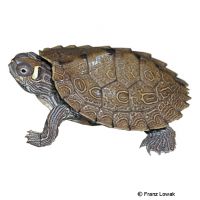Ouachita Map Turtle (Graptemys ouachitensis)
| Ouachita Map Turtle Graptemys ouachitensis | |
|---|---|
| Name | Ouachita Map Turtle |
| Name Lat. | Graptemys ouachitensis |
| Family | Pond Turtles & Box Turtles |
| Family lat. | Emydidae |
| Order | Turtles |
| Order lat. | Testudines |
| Origin | USA |
| Habitat | Rivers, ponds, swamps |
| Diet | Fish, insects, plants |
| Humidity | 50-80 % |
| Behavior | ♂ semi-aggressive |
| Keeping | Individual, harem |
| Care Level | Difficult |
| Reproduction | Oviparous |
| Housing | Aquaterrarium |
| Life Span | 25-30 years |
| Protection | CITES Appendix III; EU Annex C |
| Metric Units | |
| Size | 14-24 cm |
| Temperature | 24-28 °C |
| Temperature Local | 35-40 °C |
| Housing Size | 120 x 60 x 50 cm |
| US Units | |
| Size | 5.5"-9.4" |
| Temperature | 75-82 °F |
| Temperature Local | 95-104 °F |
| Housing Size | 50" x 25" x 20" |
Distribution and habitat
The range of the Ouachita humpback turtle is the southern United States, in the Mississippi, Missouri and Ohio river systems. There they live in fast flowing sections with dense vegetation, but they can also be found in oxbow lakes, lakes, floodplains and swamps.
Maintenance
Minimum dimensions for the aquaterrarium, according to the size and number of animals
| floor space for 1-2 animals: 5PL x 2,5PL (L x W) | Water level: 2PB |
The carapace length (PL) and carapace width (PB) is measured on the largest animal. For each additional animal, increase the footprint by 10%, and for the 5th animal and larger, increase the footprint by 20%. An aquaterrarium of e.g. L 120 x W 60 x H 50 cm is recommended, which should be placed in a quiet and vibration-free place.
It needs a spacious, well structured aquaterrarium. The water part, with a soft, muddy substrate, should be structured with roots, aquatic plants and larger stones (visual barriers and hiding places), some of which reach the water surface. For this purpose, they need a terrestrial part (approx. 1/3 of the bottom surface) for drying, which is equipped with a soft, muddy-sandy bottom substrate, with plants and roots as well as with sunning places. To maintain water quality, a powerful filter with low flow is recommended, as well as frequent water changes.
| Water Temp | lighting | Sunny | |
| Summer | 20-28 °C | 12-14 hrs. | 35-40 °C |
| winter (2-3 months) | 8-15 °C | 6-8 hrs |
They need daily UV irradiation and sunny places with radiant heat.
Diet
The diet consists of insect larvae, snails, earthworms, mealworm larvae, shrimp, fish pieces, scraped beef or liver, supplemented with pelleted or freeze-dried ready-to-eat food. Frozen food is also well accepted. Be sure to offer lettuce, dandelion, endive and aquatic plants (e.g. waterweed). Young animals should be offered food daily, adults twice a week. Regular addition of minerals and vitamins is important
A varied diet promotes health and prevents deficiency symptoms.
Reproduction and breeding
Males are almost half as small and have a much longer tail than females. The anal opening of the male is closer to the tip of the tail than in the female.
Mating takes place in the water in the spring and egg laying (up to 15 eggs) occurs between May and June. A small, sandy shore is necessary for egg laying. The incubation period is 58-74 days (usually 70 days) at a temperature of 24-30 °C.
Life expectancy can be 25-30 years.
Species protection
Species protection: WA Appendix III; EU Appendix C. Export permit required for animals from the USA
Your pet store will be happy to provide you with further information.
Important
Outside of the mating season, males and females should be kept separately because of the significant size difference (males 10-14 cm; females 16-24 cm), as there is a great risk of injury
Winter hibernation should take place in water. In summer, the animals can be kept in an outdoor facility
In order not to distort the native fauna, they must not be released into the wild under any circumstances.
The terrarium must have good ventilation without drafts and meet the species-specific needs. Measuring devices such as thermometers, hygrometers, etc. are necessary. The lighting has to correspond to the species-specific day-night rhythm and has to be placed in such a way that the animals cannot injure themselves. The terrarium should be locked in such a way that neither unauthorized persons can open it nor the animals can escape. Contamination must be removed regularly.
Further literature can be found in your pet store.
References
Text: Stephan Böhm; Image: Franz Lowak
Source: BMELV (1997): Tierschutzgutachten - Mindestanforderungen an die Haltung von Reptilien; ENGELMANN (2006): Zootierhaltung - Tiere in menschlicher Obhut: Reptilien und Amphibien, Harri Deutsch Verlag;
- Gemäß § 21 Abs. 5 Tierschutzgesetz idgF
